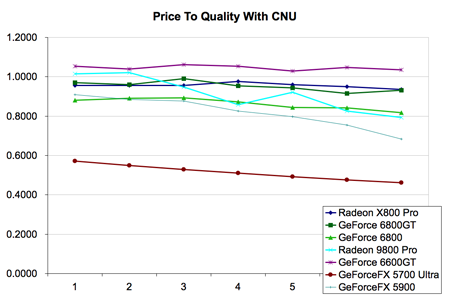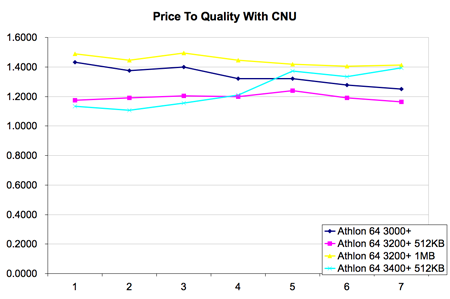Beating the System: The AnandTech Guide to Economic Upgrading
by Kristopher Kubicki & Jarred Walton on January 30, 2005 5:59 PM EST- Posted in
- Guides
A Simple Example
Now that we have the basics on what a graphical model looks like and how it functions, let us see if we can construct something similar for actual components. For this example, we are going to rewind into the past six months and base all of our devaluation assumptions on actual data pulled from our RealTime Price Engine. Suppose our hypothetical machine to upgrade looks like the following:Processor: Athlon 64 2800+ Socket 754This machine clearly looks GPU limited, but we won't let that stop us from choosing a whole subset of new components for our price set. Since we just did an article on it, the goal in this example will be to spend around $200 for a computer upgrade in order to maximize Half Life 2 performance. Once again, we need to add some padding on each end of the $200 budget so that we can have some leeway when we introduce Time into the model. Our list of products is as follows:
Memory: 512MB DDR-400
Video Card: ATI Radeon 9600 Pro
Motherboard: MSI nForce3 K8N Neo-FSR
Processor: All Socket 754 Processors better than an Athlon 64 2800+
Video Card: All AGP video cards better than a Radeon 9600 Pro
Let's plot as many of these components as possible on a graph denoting their price. We are slightly limited in our purchasing decision tree because we need to select components that fall within our designated price budget, but also components that are compatible with our hardware. This is a simple example, so we won't introduce components like memory, hard drives or motherboards for the time being. The prices were current prices as listed from the RealTime Price Engine. To keep our graphs neat, we separated video and graphics cards.
| Product | Price 6 Months Ago | Relative Quality | Product | Price 6 Months Ago | Relative Quality | |
| Radeon X800 Pro | $418.00 | 400.00% | Athlon 64 3000+ | $164.00 | 105.00% | |
| GeForce 6800GT | $412.00 | 400.00% | Athlon 64 3200+ 512KB | $230.00 | 108.00% | |
| GeForce 6800 | $295.00 | 260.00% | Athlon 64 3200+ 1MB | $205.00 | 110.00% | |
| Radeon 9800 Pro | $197.00 | 200.00% | Athlon 64 3400+ 512KB | $300.00 | 113.00% | |
| GeForce 6600GT | $228.00 | 240.00% | ||||
| GeForceFX 5700 Ultra | $175.00 | 100.00% | ||||
| GeForceFX 5900XT | $187.00 | 170.00% | ||||
This is a simple example geared toward a single application, so take these numbers with a grain of salt. You can see that we simply marked average FPS percentage increase as our quantitative values for Quality, but if we introduce more applications into our objective, we will have to use different values for Quality. We have placed some fairly conservative estimates on the relative quality between each component, but we cheated a little with the GeForce 6600GT and used the PCI Express pricing instead to demonstrate the model.
Below, you can see the actual price of each component as it changed throughout the last six months (The 6600GT is using PCIe pricing).


This looks real interesting, particularly with the subtle price swaps between each video card in the $200 segment. Now, we are just going to tilt the axis a little bit as we introduce our CNU variable of $0.25 again. After all, if our time is worthless, what is the point in upgrading this century?


Things are looking really smooth now. In every instance, it is cheaper to buy today rather than buy tomorrow when we consider the $0.25 per day that it costs us to suffer through another agonizing frag fest at substandard performance. Finally, we just need to introduce quality into the equation and see which of these components maximizes our value, and when.
August 30, 2004 would have been a particularly fun day to determine an upgrade for a new system. In retrospect, the best card to purchase at that date would have been the GeForce 6600GT – but as we mentioned earlier, we flubbed the data a little bit for that video card, since only the PCIe version existed at that point. The second best performing card, for the dollar, was the Radeon 9800 Pro. We didn't even need to consider the higher end cards, since the laws of diminishing returns automatically compensated. Since the Radeon 9800 Pro is an older SKU and its price has been relatively static, it quickly falls off the board as the best value card, but it still has a higher Price to Quality ratio than anything else around $200 – including CPUs.
All of the data from this page can be viewed in the Excel workbook here.












50 Comments
View All Comments
arud - Sunday, January 30, 2005 - link
Poser - Sunday, January 30, 2005 - link
I've been thinking about upgrading my computer for the past 6 months or more. Gutting it, really, since once the motherboard goes, most of the other components will get upped too to prevent dumb bottlenecks -- I'm looking at around six to seven hundred dollars worth of upgrades. But, the thing that's held me back ISN'T waiting for the next big thing, or for prices to drop, it's that upgrading to Half-Life 2 or Doom 3 grade hardware is worth AT MOST $150.I love this site, I consider computer hardware to be a genuine hobby, but I can't justify to myself spending more than that on playing FPS video games. The price of a good PC gaming rig is so completely out of line with what it'd cost to just pick up an Xbox that I suspect I'll be sticking with strategy games for a very long time... that or buying a current or next gen console.
Eventually, I might find some "killer app" that is actually hardware-intensive (usably good speech recognition software with excellent OS integration?), but for the moment the only thing I do that challenges even my old 1400+ Athlon XP is gaming. I just can't bring myself to think that gaming on a PC is valuable enough to justify dropping the money.
This article was a cool read, because if nothing else, it made me think to put a number on how much I really would "value" or pay for better hardware.
Dragonbate - Sunday, January 30, 2005 - link
LOL I can't help but think this article was a farce.cosmotic - Sunday, January 30, 2005 - link
Next time maybe you should tell us what we should do. Like "If this is your setup, the average person would upgrade HERE" and give what you would upgrade to. This is like trying to sell something to some one but then never actually asking them if they want to buy it. You have all these details and then no real conclusion. When SHOULD I upgrade? I have no idea, and it's not worth my time to read all this stuff and then figure it all out. Again, a nice conclusion with a concrete example would be nice. And some else that would be nice would be like arrows on the graphs that say "this is when you should upgrade and for reason X, Y, and Z". The graphs mean nothing without an explination or point.Dranzerk - Sunday, January 30, 2005 - link
I think the single hardest part of a PC is upgrading. If we did not have PC games how many here would be running the latest hardware? I would upgrade once every 2 years, instead of buying new hardware little at a time every month to make a new pc every 6 months. lolgaidin123 - Sunday, January 30, 2005 - link
Great article! Granted most people won't actually do the formulas but this is a great article to link to when people moan about waiting for the next big thing. ;)Of course if you *need* the next big thing for the purpose you will use the computer for (ie SATAII or 802.11n) you have to wait...
Gaidin
archcommus87 - Sunday, January 30, 2005 - link
But how is this reliable? The quality percentages are for one application only and even then are very estimated. And the cost per day of one quarter of NOT upgrading can vary greatly. If I'm gaming fine just now I'm not losing out on anything by not upgrading yet.MarkM - Sunday, January 30, 2005 - link
Also, I think I might add, this is a hobby for most people, not a business. The whole point is to have fun, and sometimes the excitement of researching the new hardware is the best part. A cost/benefit analysis reduces the biggest benefit for some, the fun.MarkM - Sunday, January 30, 2005 - link
Uhh ... that was interesting. Man, I'm an ANALYST for my career, I write cost/benefit analyses all the time, and even I was skimming by the last few pages of that!The one variable you didn't figure in (I think?) was the evaluator's time. Spending hours of your time calculating whehter it's workth it to spend the extra $50 may not be cost effective, in the gneral sense of resource cost. One thing I learned very early in my career is that there is a cost/beniefit ratio even in preparing the cost/benefit. If it is a relatively minor outlay, you need to apply heuristics over full blown analysis.
Still, I think this is perhaps a good intro to peopel not used to thinking in this way.
deathwalker - Sunday, January 30, 2005 - link
Ah...the benifits of being an impulse buyer. I don't have to worry about stuff like this. If you want it...get it...trash the formulas.